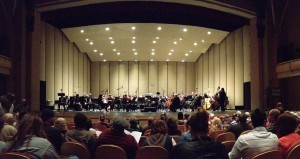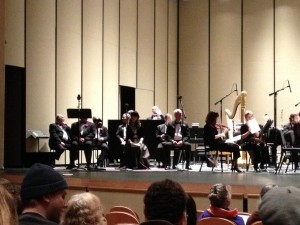“Tarzan of the Apes” was brought to life on Tuesday, Feb. 26, during a live radio broadcast at the John W. Bardo Fine and Performing Arts Center of Western Carolina University. The mainstage production packed a large crowd of WCU students and community members, all anticipating an unforgettable experience and the story of Tarzan.
The WCU radio broadcast production team did not cease to amaze the audience during its fifth collaborative production. Director, Steve Carlisle, along with Dr. Bruce Frazier, music director, Don Connelly, writer and producer, and Dr. Brian Gastle, literary researcher, took scenes from 22 episodes of Edgar Rice Burroughs’ “Tarzan” and created a masterpiece.
“Tarzan was the first live radio broadcast I have attended,” said Ashley Busman, senior at WCU. “I did not know what to expect when I first arrived, but I’m glad I came. It was an awesome experience to see how broadcasts were originally done and they did a fantastic job.”
At 7:30, the lights when down and the auditorium was glowing in green lights shaped as leaves, giving the audience the feel of actually being on the jungle island.
Connelly opened the night by welcoming the guest and introducing Frazier and the collaborative WCU and Asheville Symphony Orchestras. Frazier directed the orchestra through five pieces of music, including Walt Disney Pictures’ “Lion King Melody” by Elton John.
“The show was exciting and a completely different venue from a typical theatrical play,” said Susan Brown-Strauss, costume director for “Tarzan of the Apes.”
Act two began with Connelly’s voice booming out into the audience narrating the back story of Tarzan’s parents and how they become stranded on the jungle island. Howard Allman, Lord Greystoke, and Stefani Cronley, Lady Greystoke, then stepped up to the microphone and into character.
Allman and Cronley’s performed the death of Tarzan’s parents. The tone and emotion in their voices left nothing to the audience’s imagination as to how scared the characters were in Burroughs’ original tale. Cronley let out a series of screams that shook the crowd.
“I was playing two very different characters, I had to make very specific choices with my voce in order for an audience to imagine them as two completely separate and different women,” said Cronley. “Lady Greystoke had been in the Jungle for 2 years and bore a son. I tried to make her sound not only refined but haggard and weary because of her experiences.”
Connelly, once again, narrated Tarzan’s life 20 years after his parent’s death and before he met Jane. Connelly gave the background Burroughs’ created, explaining how Tarzan could read and write but not speak English.
Cronley stepped up the microphone again, this time as Jane. Cronley, along with Terry Nienhuis, Professor Porter, Patrick Hinkle, Philander, and Dave Evanoff as Clayton, described their journey to the jungle island and their encounter with pirates (portrayed by Allman, Hinkle, and Carlisle).
Tarzan, voice also by Evanoff, sees Jane and instantly falls in love with her. Tarzan made it his duty to care for Jane and love her. He loved Jane so much that he rescued her from the gorilla by fighting and killing it. Tarzan and Jane’s first interaction was passionate and heated. Jane fell in love with Tarzan.
Connelly’s narrative voice was perfect throughout the broadcast. Each character knew their lines and when to add emotion and anger and excitement. Carlisle’s direction was not taken lightly by the cast and that was apparent in the final production.
Throughout the broadcast, Frazier directed the orchestra to play original music written for the plan by Frazier. The live music along with the character’s presentation made for an amazing experience and an even better performance all around. As the audience left the auditorium, they were buzzing with excitement and pleasure.
“Tarzan was an exciting experience. This was how they did radio broadcasts in the ‘20s. That is so cool!” said Alan Youngberg, senior at WCU.




